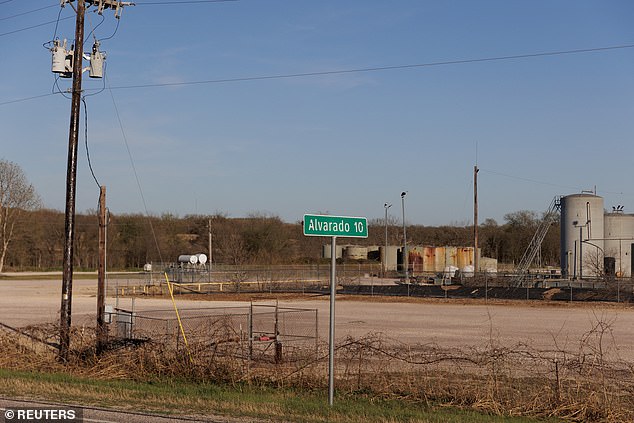Six years ago, LVMH’s billionaire CEO Bernard Arnault and President Donald Trump cut the blue ribbon on a factory in rural Texas that would make designer handbags for Louis Vuitton, one of the world’s best-known luxury brands.
But since the high-profile opening, the factory has been plagued with problems limiting the production of coveted items like the French fashion giant’s much-coveted $2,700 Vendome Opera Bag.
A senior fashion industry source who saw internal rankings shared with staff told Reuters the site has consistently ranked among the worst-performing for LVMH globally, ‘significantly’ underperforming other facilities.
Eleven former Louis Vuitton employees at the 250-acre Rochambeau Ranch in Alvarado, a rural community 45 miles southwest of Dallas, have lifted the lid on why the facility has struggled to produce the designer purses.
Leather workers at the factory lack the skills to hit the high targets needed for the bags to pass quality control, prompting many to try to cut corners, while the waste products piled up, several former staff members told Reuters.
One anonymous former employee who worked at the factory until 2023 admitted that she cut corners, like using a hot pin to ‘melt’ canvas and leather to conceal imperfections in the complicated Vendome Opera Bag.
Another former leather worker said they’d seen people melt material to hide holes or other imperfections in stitching.
Workers even struggled with simpler pieces, according to several former employees.


‘It took them years to start making the simple pockets of the Neverfull handbag,’ one source familiar with operations at the plant said, referring to the classic Louis Vuitton shoulder tote bag.
Errors made during the cutting, preparation and assembly process led to the waste of as many as 40 percent of the leather hides, said one former staffer with detailed knowledge of the factory’s performance.
Industry-wide, typical waste rates for leather goods are generally 20 percent, according to a senior industry source.
To boost production numbers, supervisors routinely turned a blind eye toward methods to conceal defects, and in some cases encouraged them, four former employees told Reuters.
Ludovic Pauchard, Louis Vuitton’s industrial director, acknowledged there had been such cases in the past, but said the issue had been resolved. ‘This dates back to 2018 and one particular manager who isn’t part of the company anymore,’ he said.
‘The ramp-up was harder than we thought it would be, that’s true,’ he added during an interview on Friday in response to detailed questions about Reuters findings.
Poorly-crafted handbags deemed unfit for sale are shredded on-site and carted away in trucks for incineration, two of the sources with knowledge of the firm’s supply chain said.
A former production supervisor who often travelled to the site, said Louis Vuitton mostly used the Texas plant for less sophisticated handbag models, producing its most expensive products elsewhere.
Pauchard said the company was being ‘patient’ with ‘a young factory.’

‘Any bag that goes out of it must be a Louis Vuitton bag, we make sure it meets exactly the same quality,’ he said. ‘I am not aware of any kinds of issues suggesting the quality coming from Texas is any different from that coming from Europe.’
The plant’s problems highlight the challenges for LVMH as it attempts to build its production footprint in the US to avoid Trump’s threatened tariffs on European-made goods.
Perched behind a hill, the handbag maker’s two production facilities were built on grounds near grazing cattle and a gas well. Louis Vuitton named the site Rochambeau in tribute to a French general who fought in the Revolutionary War.
Workers at the site make components and entire models of Louis Vuitton handbags like Felice pochettes and Metis bags – with ‘Made in USA’ tags inside. The items sell for around $1,500 and $3,000 at high-end boutiques.
LVMH declined to comment when asked which handbag models are fully or partially made in Texas but former workers interviewed by Reuters mentioned the Carryall, Keepall, Metis, Felice and Neverfull handbag lines among the plant’s products.
In its marketing material, Louis Vuitton says its handbags – typically made at French, Spanish or Italian leather ateliers by artisans known as ‘petites mains’ – are assembled using a process that it has perfected since the mid 19th century.
After cutting canvas and leather using hand tools and laser-cutting machines, they stitch pieces together using industrial sewing machines.
Workers at the Texas facility, which includes dedicated floors for cutting and for assembly as well as a warehouse, were initially paid $13 per hour.
As of 2024, base pay for a leather worker position at the plant was $17 per hour, according to two people who recently applied for positions. The minimum wage in Texas is $7.25 an hour.

A former leather worker who arrived as a migrant in the U.S. some years before, said she felt proud when she was hired by the prestigious French brand, but said some workers struggled to meet the brand’s quality standards and production targets.
‘We were under a lot of pressure to make the daily goals,’ said the former worker, who left the factory at the end of 2019.
Damien Verbrigghe, Louis Vuitton’s international manufacturing director, conceded some at the Texas plant had chosen to change jobs or leave because of its stringent quality requirements.
‘There are artisans that we hire, who we train and who, after several weeks, or months, realize in light of the expectations, the level of detail that is required, they would rather work in other fields like logistics,’ he said.
‘Some people chose to leave us, because it’s true that it’s a job that requires a lot of savoir faire.’
Three former workers at the plant said they received between two and five weeks of training.
A current Louis Vuitton employee in France said receiving just a few weeks of training wasn’t unusual as most learning happens on the production line supervised by more experienced craftspeople.
‘Knowledge of sewing on leather/canvas is a plus, but not required. We offer comprehensive training,’ the company said in a job posting for artisan positions in Alvarado published on its website in January.
Verbrigghe said training in Texas is ‘exactly the same program that we have in all our workshops,’ that is, six weeks on the training line, where new artisans do nothing but learn basic operations and skills before going on to train on the assembly line.
There, he said, they are ‘accompanied and continuously mentored by trainers.’

LVMH also got a host of tax breaks and incentives from Johnson County, including a 10-year, 75% property tax cut, promising the company an estimated $29 million in savings.
‘We look forward to serving this exceptional company,’ wrote the county’s top executive, Roger Harmon, in 2017 correspondence seen by Reuters.
In its 2017 application letter for the tax abatement, obtained by Reuters through records request, LVMH said it was aiming to hire 500 people within the first five years of the plan.
At the ribbon-cutting ceremony in 2019, Arnault said, ‘We will create approximately 1,000 high-skilled jobs here at Rochambeau over the next five years.’
Three former staffers, however, said headcount stood at just under 300 workers in February 2025, a figure Verbrigghe confirmed.
The White House did not respond to a Reuters request for comment.
Pauchard said initial recruitment difficulties were largely due to the COVID-19 pandemic and the lockdown that followed, adding that a decline in local demand also played a role.
Despite the problems, LVMH is planning to move even more jobs to Texas.
LVMH said in its 2017 filing that its first Texas production facility would cost around $30 million. A second filing from 2022 to local authorities put the cost of its second workshop, completed last year, at $23.5 million.
At a town hall last fall, workers at one of two California production sites were told that it would close 2028 and they could move to Texas or quit, according to a former employee who was present.
Pauchard confirmed the town hall and said Louis Vuitton intended to streamline its California operations and transfer more skilled artisans to Texas – with so far limited success.
Its executives, he said, ‘underestimated the fact that Texas is far away from California.’
This post was originally published on this site be sure to check out more of their content.




